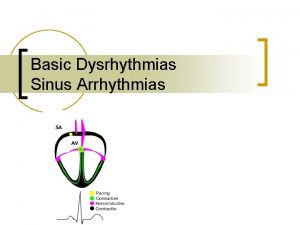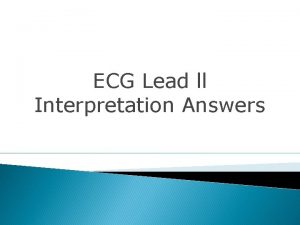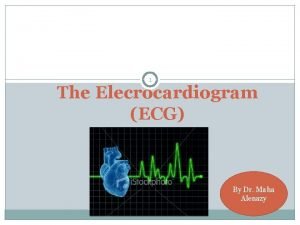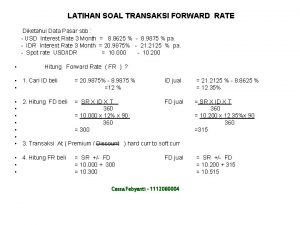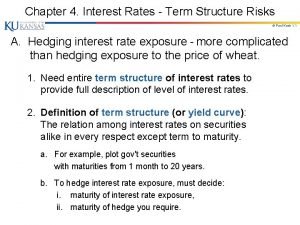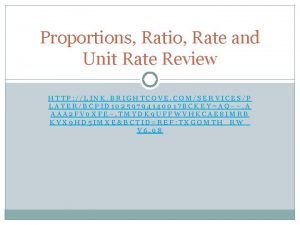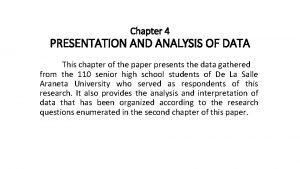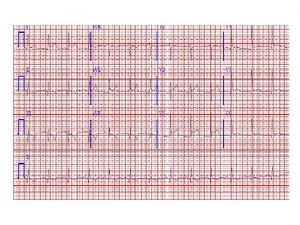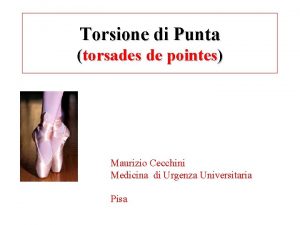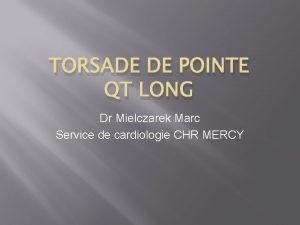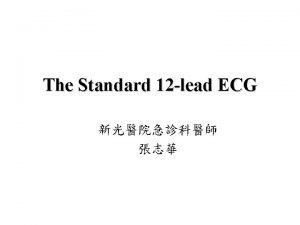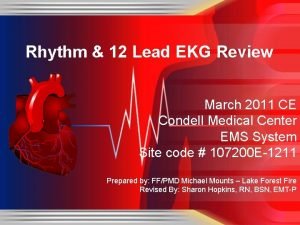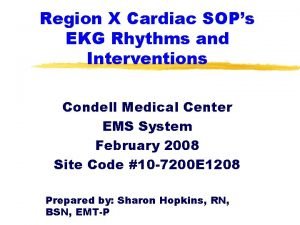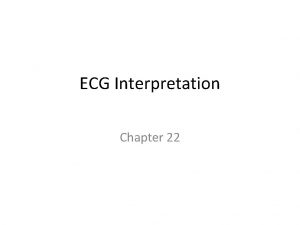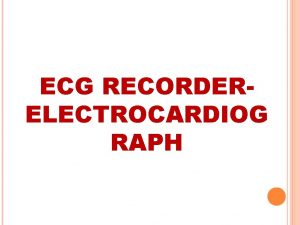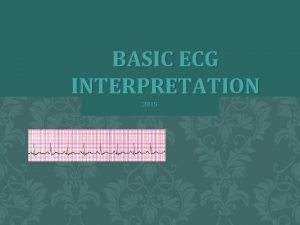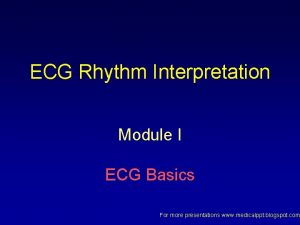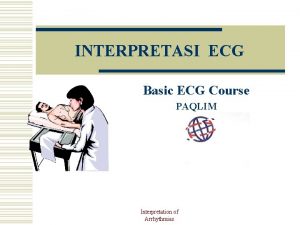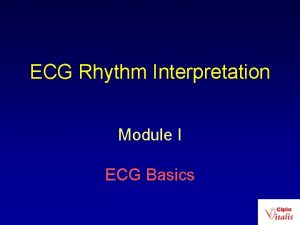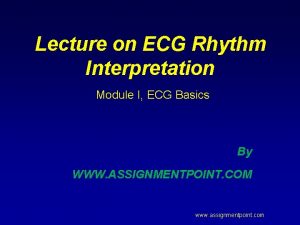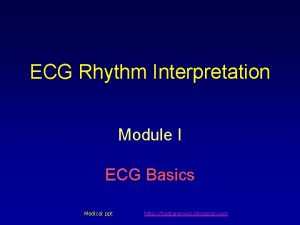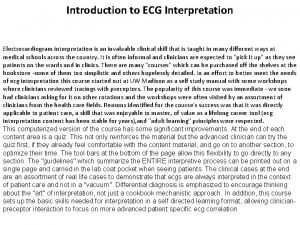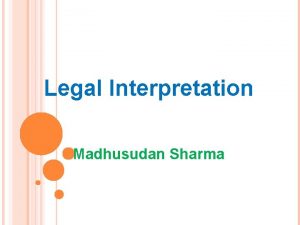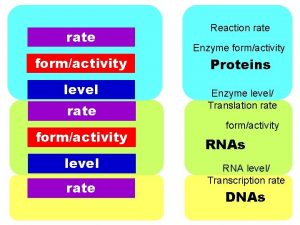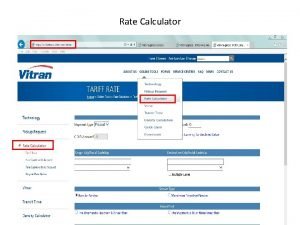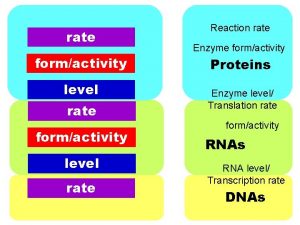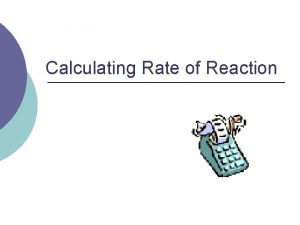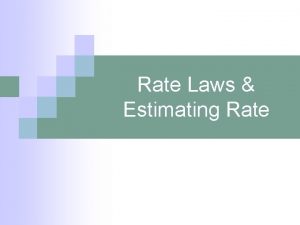ECG Interpretation Chapter 22 ECG Interpretation 1 Rate

























- Slides: 25

ECG Interpretation Chapter 22

ECG Interpretation 1. Rate 3. Axis a. Atrial rate: PP interval 4. Hypertrophy b. Ventricular rate: RR interval 5. Blocks 2. Rhythm a. P wave b. PR interval c. QRS i. voltage (height) ii. width 6. Infarct 7. Ischemia

Standardization mark 10 mm vertical deflection = 1 m. Volt

Rate Ventricular rate (heart rate) RR interval Atrial rate PP interval 3 rd degree AV block

Heart Rate Calculation 1500 divided by the number of small boxes between two R waves • most accurate • take time to calculate • only use with regular rhythms • quick 300 divided by the number • not too accurate of large boxes between • only use with regular two R waves rhythm 10 multiplied by the number of R waves in 6 seconds • less precise • use with irregular rhythms • very quick 1 lg sq = 300 bpm 2 lg sq = 150 bpm 3 lg sq = 100 bpm 4 lg sq = 75 bpm 5 lg sq = 60 bpm 6 lg sq = 50 bpm

Rhythm Sinus rhythm - consistent P waves Atrial rhythm - irregular P waves Junctional/Nodal rhythm - no P waves, late P waves, or inverted P waves Ventricular rhythm - no P waves, wide QRS

AV Junctional Rhythms Retrograde P waves immediately preceding the QRS complexes in a. VR and II. Retrograde P waves immediately following the QRS complexes Absent P waves

ECG Waves P wave atrial depolarization ≤ 2. 5 mm in amplitude < 0. 12 sec in width PR interval (0. 12 - 0. 20 sec. ) time of stimulus through atria and AV node prolonged interval = first-degree heart block

P wave Tall = RAE Wide = LAE

PR Interval Long PR interval = first degree AV block Short PR interval = WPW Short PR interval with inverted P waves = ectopic atrial or junctional pacemaker

Classification of AV Heart Blocks Degree Block Uniformly prolonged PR interval Degree, Mobitz Type I Progressive PR interval prolongation 1 St 2 nd AV Conduction Pattern 2 nd Degree, Mobitz Type II Sudden conduction failure 3 rd Degree Block No AV conduction

Wolff-White-Parkinson Wide QRS due to early depolarization not due to a delay in depolarization Shortened PR interval Upstroke QRS complex is slurred; delta wave

ECG Waves QRS width 0. 12 second or less

Normal QRS V 6? V 1? Fig. 4 -6 V 1? V 6?

Normal Q waves • Septal r wave • Septal q wave

Q Waves Abnormal if wider than 0. 04 sec Leads I, III, a. Vf or leads V 3 - V 6. Greater than 25% of the R wave Note: Not all Q waves are abnormal, Not all Q waves are the result of MI.

QRS Width Wide RBBB or LBBB Premature ventricular beats WPW

QRS Voltage RVH LVH

Mean QRS Axis

Axis Deviation LEAD a. VF LEAD I (or Lead II or III) Normal Positive LAD Positive Negative RAD Negative Positive Intermediate axis Negative LEAD a. VR Positive (or Negative)

R Wave Progression

Transmural MI Ischemia Tall T waves (and/or reciprocal T wave inversion) ST segment elevation. Injury T wave inversion of the previously tall T waves Pathalogical Q waves Infarct (at least one small box wide or 11/3 the entire QRS height)

Overview LEAD AREA OF THE HEART V 1 -V 2 Anterior/Septum V 3 -V 4 Anterior Wall V 5 -V 6 Anterior/Lateral II, III, a. VF Inferior I and a. VL Lateral V 1 -V 2 Posterior (reciprocal)

ST Segments J point: end of QRS wave beginning of ST segment beginning of ventricular repolarization normally isoelectric (flat) changes, elevation or depression, may indicate pathological condition

Subendocardial Ischemia ST segment depression criteria 1 mm or more horizontal or downward lasts 0. 08 seconds depression of only the J point with rapid upward sloping are considered normal.
 Ecg rhythm strip interpretation basic lesson 5
Ecg rhythm strip interpretation basic lesson 5 Ventricular standstill ecg
Ventricular standstill ecg 1500 method ecg
1500 method ecg How to calculate heart rate from ecg
How to calculate heart rate from ecg How does interpretation b differ from interpretation a
How does interpretation b differ from interpretation a Cap rate interest rate relationship
Cap rate interest rate relationship Real vs nominal interest rate
Real vs nominal interest rate What is plant growth analysis
What is plant growth analysis Contoh transaksi forward
Contoh transaksi forward Addison currency exchange
Addison currency exchange Yield to worst
Yield to worst 1 year forward rate formula
1 year forward rate formula Unit rate proportions
Unit rate proportions Presentation and analysis of data
Presentation and analysis of data Has the exchange rate changed chapter 10
Has the exchange rate changed chapter 10 Has the exchange rate changed chapter 10
Has the exchange rate changed chapter 10 Types of pathology
Types of pathology Melvin rivera
Melvin rivera Ecg torsione di punta
Ecg torsione di punta Torsade de pointe ecg
Torsade de pointe ecg Einthoven
Einthoven What is this
What is this Ecg lead placement
Ecg lead placement R on t
R on t Pea ecg rhythm
Pea ecg rhythm Sick sinus syndrome ecg
Sick sinus syndrome ecg
